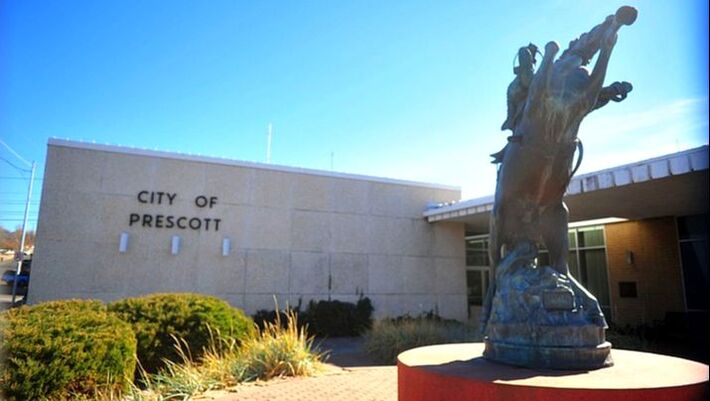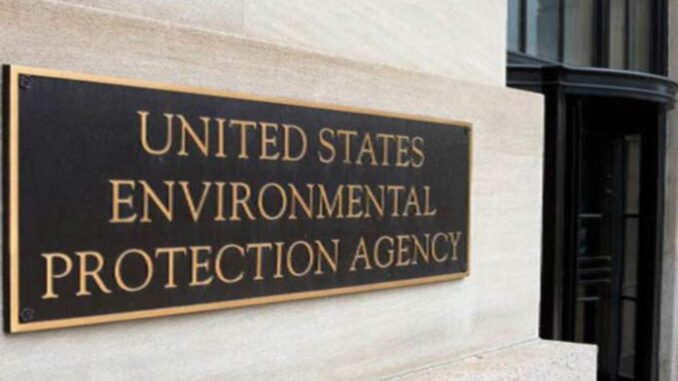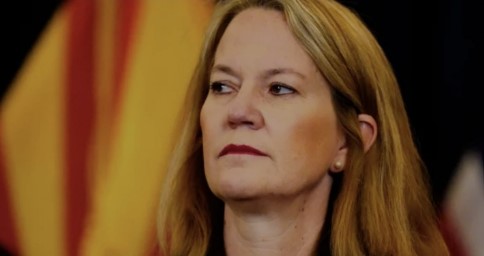
by Matthew Holloway | Dec 2, 2025 | News
By Matthew Holloway |
Jim Griset, the proprietor of a souvenir store, an art gallery, and a Harley Davidson shop in Prescott, has secured a hard-fought victory in his efforts to bring his vision of a new hotel to the city’s historic downtown. Represented by Goldwater Institute attorney Jon Riches, Griset’s victory successfully overturned a City Council ruling that upheld the Prescott Preservation Commission’s denial of his permit.
According to the Goldwater Institute, Griset has sought to transform three buildings he already owns on Prescott’s historic Whiskey Row into a hotel. The buildings already house his existing businesses, but he has endeavored since 2023 to bring the hotel into being that would “complement the surrounding architecture and preserve the charm and character that make Prescott special.”
As noted by Goldwater, none of the buildings in question are listed as historic. Still, they are located within the city’s designated historic district and thus require approval from the Preservation Commission.
Writing for Goldwater Riches explained:
“When Jim first submitted his application in 2023, the commission rejected it—not based on any clear or objective standards, but in response to NIMBY [not-in-my-backyard] opposition and vague impressions. Instead of pointing to identifiable criteria in the city’s preservation code, the commission relied on subjective notions like whether the design was ‘respectful’ of the district’s ‘intimate scale.’
Those terms don’t appear anywhere in the law. They’re not defined. They’re entirely subjective—which is exactly what the law is supposed to prevent.”
The law Riches refers to is The Permit Freedom Act, a Goldwater Institute-developed law enacted in 2023. He notes, “The Act prohibits local governments from making new rules midstream or applying vague, subjective standards to block lawful use of private property. And that is precisely what Prescott did.”
When Griset applied for the permit and was denied, he reportedly took the commission’s feedback, revised his designs, and worked to meet the standards set. “Yet every time he met the standards placed before him, the standards seemed to change,” Riches wrote.
When the denial was appealed to the Prescott City Council, the Council ruled against Griset. The council brought in a neutral historic preservation expert, who found that Griset had met the standards, and Goldwater attorneys brought the potential violation of the Permit Freedom Act to the City’s attention. Goldwater told the city, “Based on this review, under the Permit Freedom Act, there was simply no legal criteria authorizing the denial of his permit,” per Riches. However, the Commission again ruled 3-2 against Griset and his hotel plans.
Riches noted that in 2024, Prescott’s City Council sold the old City Hall building to a property developer with similar plans for a four-story hotel in the very same district. But it wasn’t rejected by the Commission or Council.
On November 4th, the City Council heard Mr. Griset’s appeal. Riches wrote, “Several council members spoke openly about the importance of private property rights and the need for fair, consistent rules—not decisions driven by subjective preferences or political pressure. Members of the public echoed the same: government rules must be fair, consistent, and objective. They should not favor some over others.”
Riches concluded, “Property owners in Prescott, and across Arizona, deserve certainty. They deserve to know the rules before they invest. When government shifts the rules or invents new ones as it goes, it undermines confidence, deters investment, and violates the law.”
The council voted to overturn the Preservation Commission’s decision. Mr. Griset’s hotel plan is pending approval from Prescott’s city zoning and planning commission and, subsequently, from the Council. A water service agreement will also require approval.
Matthew Holloway is a senior reporter for AZ Free News. Follow him on X for his latest stories, or email tips to Matthew@azfreenews.com.

by Matthew Holloway | Dec 1, 2025 | News
By Matthew Holloway |
The U.S. Environmental Protection Agency (EPA) has filed a motion in a federal appeals court to vacate a Biden-era rule on fine particulate matter air quality standards, which was set to affect air quality regulations in Arizona.
In the motion filed in the U.S. Court of Appeals for the D.C. Circuit, Department of Justice attorneys representing the EPA told the D.C. Circuit that the agency’s 2024 rule change on fine particulate pollution standards is both legally and scientifically flawed and must be vacated. The motion noted that the “supplement” to the EPA’s 2019 Assessment of the NAAQS, or National Ambient Air Quality Standards, for particulate matter, “did not represent [a] full multidisciplinary evaluation of evidence’ for the underlying air quality criteria.” It added that the agency “lacks statutory authority to revise standards absent a thorough review.”
The PM 2.5 rule, finalized on December 15, 2024, was purported to strengthen protections against fine particulate matter pollution, which the EPA stated was linked to respiratory and cardiovascular health risks. Implementation was set to begin in 2025, with full compliance deadlines extending to 2031. The final rule revising the NAAQS lowered the annual primary PM 2.5 standard from 12.0 micrograms per cubic meter to 9.0 micrograms per cubic meter. The rule also established a new 24-hour PM 2.5 standard of 35 micrograms per cubic meter. The rule remains in effect until the court comes to a decision.
The consolidated lawsuits involved petitioners including the Commonwealth of Kentucky, et al., the Arizona Legislature, and the Arizona Chamber of Commerce, along with 21 other states and business groups against the U.S. Environmental Protection Agency, et al. The states and business groups challenged the rule, arguing it would impose billions in compliance costs on states like Arizona, potentially halting construction projects and job growth in areas struggling to meet the stricter standards.
The petitioners contended that the new limits would classify more areas as being in a state of nonattainment, leading to economic restrictions under the Clean Air Act. Oral arguments in the case were heard on December 16, 2024.
Arizona Senate President Warren Petersen hailed the EPA’s motion on X on November 26, 2025, crediting EPA Administrator Lee Zeldin with what he called a “BIG WIN FOR ARIZONA!” He added that the EPA, “just filed a motion in federal court to throw out Biden’s unlawful PM 2.5 rule that made it nearly impossible for parts of Arizona to ever meet clean-air standards — a rule that would have crushed jobs, construction, and our economy with billions in costs. The AZ Legislature & the AZ Chamber sued the Biden admin to stop this job-killing regulation. Our lawsuit helped bring about this reversal. Thank you, President Trump, for keeping your promise to cut red tape and protect Arizona families!”
Adam R.F. Gustafson, Principal Deputy Assistant Attorney General, and Sarah I. Zafar, Trial Attorney in the DOJ Environment and Natural Resources Division, filed the EPA’s motion for vacatur. They wrote in part, “Implementation of the NAAQS is a complex process, which generates significant costs and reliance interests among States, local governments, and regulated parties.”
The DOJ attorneys also argued that the EPA, “should at least have considered the distinct costs associated with revising the NAAQS mid-cycle. EPA’s disregard of this relevant factor was arbitrary and capricious because it was unreasonable for EPA to read an exercise of discretionary authority as an invitation to ignore a relevant factor like cost.”
The case remains ongoing in the U.S. Court of Appeals for the D.C. Circuit.
Matthew Holloway is a senior reporter for AZ Free News. Follow him on X for his latest stories, or email tips to Matthew@azfreenews.com.

by Matthew Holloway | Dec 1, 2025 | News
By Matthew Holloway |
The Ak-Chin Indian Community has been selected as the only Arizona tribe chosen for the Indian Health Service’s Joint Venture Construction Program (JVCP) for Fiscal Year 2025, a federal partnership that will fund and staff a new comprehensive health center for the community.
The JVCP, launched in 1991 under the Indian Health Care Improvement Act, allows tribes to finance and construct healthcare facilities that meet IHS standards. In return, the Indian Health Service requests funding from Congress to staff, equip, and operate the facilities for 20 years under a no-cost lease agreement.
According to an announcement from Congressman Eli Crane (R-AZ-02), the Ak-Chin Indian Community, located in northwestern Pinal County within Crane’s district, was selected through a competitive national application process. The Congressman celebrated the decision, calling it “a historic investment in rural healthcare” and noting that the partnership would “expand access to quality care and help close longstanding gaps in Arizona’s Second District.”
A letter from the IHS to Tribal leaders states that participants in the JVCP “acquire, construct, or renovate a health care facility” and that IHS will operate the completed facility for the duration of the lease period. The letter confirms Ak-Chin’s selection among the FY 2025 participants.
Over thirty facilities have been constructed under this program, including both health centers and hospitals, serving more than 25 tribes nationwide, according to the IHS.
Ak-Chin Indian Community Chairman Gabriel Lopez praised the federal decision, saying the partnership “will enable us to replace our current aged and inadequate health clinic to meet the needs of our growing population,” by enabling community members, including elders and those with chronic conditions, to access care closer to home.
Specific service offerings for the new facility will be defined as the project moves forward. Lopez added, “Going forward, this new health center with comprehensive services will ensure high-quality care is available right here and will make a real difference in the quality of life for the Ak-Chin people,” according to Native News Online.
Lopez also thanked Crane and Arizona’s congressional delegation for supporting the tribe’s successful application.
“This healthcare facility would not be possible without our Arizona delegation members, including Congressman Crane. We thank Congressman Crane for his support, which was essential in the success of our application and reflects his steadfast advocacy for the Ak-Chin Indian Community and each of the Tribes within his district,” Lopez said.
The Chairman met with U.S. Secretary of Health and Human Services Robert F. Kennedy Jr. in Scottsdale this week to announce the award for the Joint Venture Construction Program. Kennedy described the existing urgent care facility on Ak Chin tribal land as “essentially a double-wide trailer” in the video message.
In a post to X, HHS stated the funding will “build an approximately 60,000-square-foot health facility to expand access to primary, dental, and radiology care for the Ak-Chin community and neighboring tribes, improving access to care in rural Arizona.”
Thanking the Trump administration and Secretary Kennedy, Lopez said, “This is a tremendous honor, and it’s a tremendous surprise and a blessing for our community. Again, thank you to the Administration, thank you, Secretary.”
Matthew Holloway is a senior reporter for AZ Free News. Follow him on X for his latest stories, or email tips to Matthew@azfreenews.com.

by Jonathan Eberle | Dec 1, 2025 | News
By Jonathan Eberle |
A new analysis shows Arizona is among the states most vulnerable to real estate scams during the holiday season, as buyers and sellers rush to close deals before the end of the year. A study released by PPS House Buyers reviewed Federal Trade Commission data from 2022 to 2024 and found that Arizona records an average of 2.04 real estate scam reports per 100,000 residents between October and December—placing it fifth in the nation. Victims in the state lose an average of $18,025 per incident, a figure notably higher than the national average loss of $16,369.
Nevada tops the list for winter scam exposure, averaging 2.64 reports per 100,000 people during the final quarter of the year. The state also saw $1.39 million in total losses across 86 reports, with each victim losing more than $16,000 on average. Georgia and Florida follow closely behind, with 2.29 and 2.23 reports per 100,000 residents, respectively. Florida also experiences the steepest total financial toll, with annual Q4 losses topping $7.2 million.
Although Alaska ranks fourth overall, the state’s smaller population means only about 16 scams are reported each year. Still, losses total more than $170,000 annually. In Arizona, the combination of rapid population growth, high homebuyer demand, and holiday transaction pressure may be contributing to the state’s elevated risk level. The average loss per victim in Arizona—$18,025—is one of the highest among the top 10 most vulnerable states.
Colorado, South Carolina, Virginia, Missouri, and Hawaii round out the top ten, all posting scam report rates well above the national average of 1.14 reports per 100,000 residents. At the opposite end of the spectrum, North Dakota sees the fewest winter real estate scam reports—just 0.17 per100,000 residents. But despite its low report rate, the state ranks near the top in average financial damage, with victims losing an average of $76,142 per incident.
Wisconsin and Iowa follow as the second- and third-lowest states for scam frequency. Arkansas and Rhode Island complete the five states least affected by winter real estate scams, though Arkansas reports an unusually high per-victim loss of $17,828. While Nevada generates the most reports, Wyoming and North Dakota see the most severe individual financial harm. Wyoming victims lose an average of $80,694, nearly five times the national average. North Dakota follows closely at just over $76,000 per scam.
Joel Medrano, CEO of PPS House Buyers, said the combination of consumer urgency and reduced attention during year-end planning makes the holiday season particularly dangerous. “The holidays create the perfect storm for real estate scams, as buyers feel pressure to close before Christmas, and scammers exploit that urgency with deals that seem too good to miss,” Medrano said. “Anyone involved in real estate transactions should verify all parties through official channels, never wire money based on email instructions alone, and be especially cautious of deals that seem unusually urgent or pressure you to act quickly.”
Jonathan Eberle is a reporter for AZ Free News. You can send him news tips using this link.

by Matthew Holloway | Nov 30, 2025 | News
By Matthew Holloway |
Arizona Senate President and AG candidate Warren Petersen says that Democrat Attorney General Kris Mayes is overseeing a “culture of corruption,” pointing to a federal probe request and the arrest of a top aide as signs of a deepening crisis inside the Attorney General’s Office.
In a statement emailed by his campaign, Petersen said a “pattern of misconduct, corruption, and political weaponization” had taken root under Mayes and now represents “a betrayal of public trust” for Arizona families, law enforcement, and state institutions.
Petersen highlighted two recent developments: a formal request from U.S. Rep. Abe Hamadeh for a federal investigation into alleged bribery and prosecutorial misconduct and the arrest of Mayes’ state government division chief, Vanessa Hickman, on felony charges linked to stolen property.
Hamadeh Seeks Federal Probe Into Alleged ‘Pay-to-Play’ Scheme
Petersen’s statement leans heavily on a recent move by Congressman Abe Hamadeh (R-AZ08), who has asked the U.S. Department of Justice to investigate what he calls a “coordinated bribery and prosecutorial misconduct scheme” involving Mayes, the Democratic Attorneys General Association (DAGA), and the States United Democracy Center (SUDC).
In a detailed letter, Hamadeh pointed to court filings in the ongoing alternate electors prosecution and alleged that DAGA sent a total of $200,000 to Mayes’ political operation during key points in the case:
- $50,000 shortly after Mayes retained SUDC in May 2023
- $150,000 shortly after indictments were announced in April 2024
Hamadeh argued that the timing raises “significant concerns about quid pro quo arrangements,” and criticized what he described as an “unprecedented attorney-client relationship” between the Attorney General’s Office and SUDC, a politically aligned nonprofit tied to national Democratic legal networks.
“Many of the individuals involved in this scheme have engaged in highly questionable activity, and as I wrote in my letter to Attorney General Bondi, their rogue and unethical conduct is not isolated to Arizona,” Hamadeh said.
“As a former prosecutor, it is unimaginable to me that these officers of the court allegedly conspired to deny citizens their fundamental constitutional rights. Yet, it appears that is exactly what happened.”
The Department of Justice has not publicly indicated whether it will open a formal investigation, and Mayes’ office has not yet issued a direct response to Hamadeh’s allegations, according to recent coverage.
Mayes Division Chief Arrested on Felony Charges
The second case cited by Petersen is the arrest of Vanessa Hickman, who served as state government division chief under Mayes. Hickman was arrested last week by U.S. Postal Inspection Service agents and faces two felony counts of “controlling and trafficking stolen property” tied to a misdelivered package containing roughly $40,000 in jewelry, according to Phoenix New Times.
In a statement to the outlet, Mayes’s spokesman, Richie Taylor, said, “The allegations against Ms. Hickman are serious for any state employee, particularly someone in a leadership position.”
Hickman was placed on administrative leave after federal authorities notified the Attorney General’s Office of the investigation, and later resigned. However, she was still listed on the agency’s website as of this week, the Times reported.
Petersen argued that Hickman’s brush with the law was preceded by “serious allegations against Hickman—including fraud, conversion, and breach of fiduciary duty.”
“Mayes’ office had been warned by the city of Peoria nearly two years earlier about serious allegations against Hickman—including fraud, conversion, and breach of fiduciary duty—yet Mayes kept her in a position of authority,” the statement said.
Before joining Mayes’ team in January 2023, Hickman served as Peoria’s city attorney. The City of Peoria later sued Hickman over a six-figure severance, accusing her of unjust enrichment linked to a $139,000 payout the city says she wasn’t entitled to, according to the Arizona Republic.
According to an Arizona Daily Independent report, Peoria Mayor Jason Beck sent a letter to Mayes in March warning about those allegations and urging the Attorney General to investigate. Mayes declined the request and dismissed it as a “political stunt.”
“These incidents are not accidents,” Petersen said of both the Hamadeh complaint and Hickman’s arrest. “They are the direct result of failed leadership and a culture of corruption that Kris Mayes has allowed to take root in the Attorney General’s Office.”
Hickman has previously pushed back on Peoria’s claims. She filed a defamation countersuit against city officials over their communications with Mayes’ office, which was dismissed by a Maricopa County Superior Court judge on Jan. 7, according to court records and local reporting per AZCentral.
The current criminal case against Hickman has been submitted to the Maricopa County Attorney’s Office for a charging decision. However, county prosecutors said they had not yet received it as of last week, according to Phoenix New Times.
“I will restore honesty, transparency, and integrity,” Petersen said in his release. “I will rebuild trust with law enforcement and put the full weight of the Attorney General’s Office back where it belongs—behind the safety, security, and rights of Arizona families. This race is about defending every neighborhood, rural community, border town, and law-abiding Arizonan.”
On his campaign site, Petersen frames his bid as an effort to “restore trust to Arizona’s Attorney General Office” and to enforce the law “as written—not based on politics or personal opinion,” emphasizing backing for law enforcement, crime-victim rights, and protecting Arizona’s sovereignty against “unconstitutional mandates, burdensome regulations, and attacks on our rights.”
Matthew Holloway is a senior reporter for AZ Free News. Follow him on X for his latest stories, or email tips to Matthew@azfreenews.com.

by Jonathan Eberle | Nov 30, 2025 | News
By Jonathan Eberle |
Amazon has agreed to pay a total of $2.5 billion in penalties and customer refunds to resolve a federal lawsuit alleging the company improperly enrolled users in its Prime membership program and made it difficult for them to cancel, according to a settlement announced on Sept. 25. The agreement stems from a 2023 Federal Trade Commission (FTC) lawsuit accusing Amazon of using deceptive design tactics—often called “dark patterns”—that allegedly pushed customers into Prime subscriptions without their informed consent. The company has repeatedly denied any wrongdoing but said it is settling the case to move forward.
According to court filings, $1.5 billion of the settlement will be distributed directly to Prime subscribers. Refunds will be capped at $51 per customer and automatically issued to eligible users within 90 days of the settlement taking effect. Those eligible for automatic payments include customers who were enrolled in Prime through specific online flows such as “Single Page Checkout” and similar enrollment pages between June 23, 2019, and June 23, 2025.
The FTC alleged that Amazon knowingly designed confusing interfaces that nudged or steered customers toward Prime subscriptions. The agency said internal documents revealed discussions among company executives acknowledging problems with both the enrollment path and the cancellation process. “Amazon created confusing and deceptive user interfaces to lead consumers to enroll in Prime without their knowledge,” the FTC said in its announcement. The complaint also accused the company of creating a “complex and difficult” cancellation process that impeded users’ ability to leave the service.
Under the settlement terms, Amazon must revise its user interface to ensure clearer options when customers are signing up for—or declining—Prime. That includes a requirement for a prominent ‘decline Prime’ button and more straightforward cancellation tools. In a statement released the same day, Amazon rejected the claims but said the agreement allows the company to avoid prolonged litigation.
“Amazon and our executives have always followed the law, and this settlement allows us to move forward and focus on innovating for customers,” the company said. It added that it works to make Prime enrollment and cancellation “clear and simple” and emphasized the value Prime offers to millions of subscribers worldwide. With the settlement now approved, Amazon will begin issuing refunds and overhauling portions of its checkout and subscription processes. Meanwhile, the company will pay the remaining $1 billion of the settlement as a civil penalty to the federal government.
Jonathan Eberle is a reporter for AZ Free News. You can send him news tips using this link.






